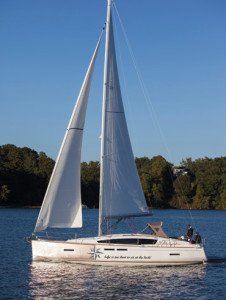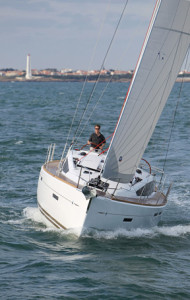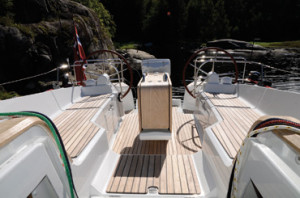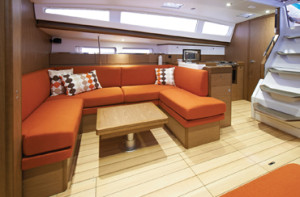 Jeanneau Sun Odyssey 41DS • The new deck saloon design embraces simple cruising elegance while offering innovative sailing systems.
Jeanneau Sun Odyssey 41DS • The new deck saloon design embraces simple cruising elegance while offering innovative sailing systems.
The October afternoon we set off from the docks in Back Creek near Annapolis, we had aboard Jeanneau America president Paul Fenn and national sales manager Jeff Jorgenson plus BWS’s new online editor Andrew Cross. Good sailing hands all around. Andy took the helm as we dropped the mooring lines and expertly backed the 41DS out of the marina and into the channel, then spun it around and put the throttle down as we headed down creek and into the Chesapeake Bay.
Under power, the 41DS handles easily and well. With a sail drive powered by the standard 40hp diesel, the prop is well positioned to keep water pressure on the rudder, thus even at slow speeds the boat turns with assurance. Straight ahead, the boat will motor at 6.5 knots at a conservative 2000 rpms, yet will climb to her theoretical hull speed of 8.04 knots without much bother at 2800 rpms—just short of the maximum we noted given the fixed three bladed prop.
 Out in the bay we rolled out the mainsail and then headed off to roll out the jib. As we did this we made use of the electric winch on the cabintop to haul out the main’s clew and then trimmed the main with the cool new reversing sheet winches built by Harken. The mainsail has been set up with a double-ended main sheet that tails to sheet winches at both helms (the 41 has twin wheels). This arrangement allows the helmsman to trim the main from either wheel, and the reversing winch action allows him to do so with the push of a button—in or out.
Out in the bay we rolled out the mainsail and then headed off to roll out the jib. As we did this we made use of the electric winch on the cabintop to haul out the main’s clew and then trimmed the main with the cool new reversing sheet winches built by Harken. The mainsail has been set up with a double-ended main sheet that tails to sheet winches at both helms (the 41 has twin wheels). This arrangement allows the helmsman to trim the main from either wheel, and the reversing winch action allows him to do so with the push of a button—in or out.
With battenless mainsail drawing, we next rolled out the 106 jib and sheeted it in. There is a story about the small size of the jib that has a lot to do with the action of the reversing sheet winches. In the not too distant future, you will be able to instruct your autopilot to tack. The instruments will change the helm appropriately and then ease the working, leeward sheet while the windward winch grinds in the new sheet as the boat’s bow passes through the eye of the wind. What you have is a self-tacking sloop with a slightly overlapping jib. This is new technology that Harken and the major electronics companies are working on in order to make sailing simpler and easier.
With the sails drawing, we hardened up onto the wind and trimmed for close-hauled sailing. The main was fairly flat, so we could crank it in to an impressive degree. The jib, with tight sheeting angles to the genoa cars on tracks on top of the cabin house, was a handsome blade sail that trimmed up well and gave the boat a remarkably close sailing angle of 40 degrees true wind. In the 10 to 12 knots of breeze, we were able to eek out nearly 7 knots upwind.
As we fell off the wind we could feel the 41 make use of her highly efficient hull despite the lack of sail area in the headsail. For cruising, sailors would want to add a fairly flat cut reacher on a roller to give the 41 some sporty speed and deeper angles off the wind.
The 41DS showed itself to be a handy cruiser that motors well and maneuvers easily in tight quarters and a fine sailing design that is intended to make performance cruising easier than ever. This boat can certainly be handled by a couple and is also a cinch for those who sail alone.
THE DESIGN
Philippe Briand did the basic hull design work when he drew the lines for the Jeanneau 409. The 41DS uses the same hull, keel and rudder as the 409 but has been given an entirely different deck and interior. The 409 was one of the most successful new designs in Jeanneau’s line in recent years and has earned the reputation of being a quick and capable racer-cruiser.
The distinctive features of the hull are the nearly plumb bow, the forward-raking stern profile with a modest swim platform, and the hard chines in the after sections of the hull, which expand interior volume in the after cabins and add a touch of hull stability when power reaching.
 On deck, the cockpit of the 41DS makes you feel like you are on a 45-footer, with twin wheels, a handsome teak table and long bench seats. The stern platform has a telescoping swim ladder, a locker for masks and snorkels, and a hand shower. The cockpit has a teak floor and inlaid teak in the seats. The helming positions from both sides are comfortable, secure and close to all sheets and winches.
On deck, the cockpit of the 41DS makes you feel like you are on a 45-footer, with twin wheels, a handsome teak table and long bench seats. The stern platform has a telescoping swim ladder, a locker for masks and snorkels, and a hand shower. The cockpit has a teak floor and inlaid teak in the seats. The helming positions from both sides are comfortable, secure and close to all sheets and winches.
The raised deck design creates a very secure cockpit as the coamings rise to meet the curved angle of the cabintop and form one simple arch profile. When you climb out to go forward, a well-placed teak step gets you to deck level. Going forward, the sidestays run to chainplates at the cabinside so they are not in your way. The foredeck is large enough to carry an eight-foot RIB upside down when on passage.
All in all, the cockpit and deck layouts are the result of extensive design experience that puts safety and sailing qualities on level footing with style and comfort.
The 41DS’s non-dimensional design numbers are right in the middle of production cruisers, with a displacement-to-length ratio of 166, a sail area-to-displacement ratio of 17.2 and length-to-beam ratio of 2.77.
LIVING ABOARD
The 41DS comes in only one version, with a master cabin aft featuring a huge double berth, a large en suite head and a separate shower. We tested the headroom of the berth since it is tucked under the cockpit sole, and yes—a six-foot human can sit up without banging his or her head.
The forward guest cabin is only slightly less elegant and commodious, with a double V-berth and a second large head and shower.
 The saloon has an L-shaped galley to starboard at the foot of the companionway stairs; the galley has twin stainless steel sinks with a unique sink cover that folds back to offer a useful place to store cups and so forth in bouncy weather. The fridge is huge and the propane stove more than adequate for two couples living and eating aboard.
The saloon has an L-shaped galley to starboard at the foot of the companionway stairs; the galley has twin stainless steel sinks with a unique sink cover that folds back to offer a useful place to store cups and so forth in bouncy weather. The fridge is huge and the propane stove more than adequate for two couples living and eating aboard.
 The dinette will seat six around the table with four on the fixed seats and two on a portable bench. Across from the dinette is a bench settee with the chart table at its after end.
The dinette will seat six around the table with four on the fixed seats and two on a portable bench. Across from the dinette is a bench settee with the chart table at its after end.
The boat is illuminated during the day via a host of opening hatches and windows and at night by arrays of flush-mounted LEDs and LED lamps at the berths and chart tables. The interior spaces feel huge and bright and will make anyone comfortable, whether sailing offshore or moored to a marina.
The fit and finish of the new generation of Jeanneaus continues to impress with attention to detail and the depth of the seamanship that informs decisions about where to put things and how to build them—enough to make any owner proud.
BWS THOUGHTS
BWS was the first magazine in North America to test the new 41DS and the first to publish a review based on a test. And we feel honored to be the first to say that the new Jeanneau takes sound production building efficiencies and methods and uses them to create a new boat that can fulfill the sailing desires of almost any cruising couple.
 The 41DS is easy and fun to sail and fast to boot. The cockpit is as comfortable as any you will find in this size range, and the sailing systems are innovative. Down below, the somewhat traditional interior (by modern Euro standards) will appeal to the American market, as will the overall quality of the craftsmanship that goes into the boat.
The 41DS is easy and fun to sail and fast to boot. The cockpit is as comfortable as any you will find in this size range, and the sailing systems are innovative. Down below, the somewhat traditional interior (by modern Euro standards) will appeal to the American market, as will the overall quality of the craftsmanship that goes into the boat.
Like the 409 in the racer-cruiser slot of the market, the new 41DS promises to offer her owners a ton of great cruising at a price that is a very good value both today and in the future, when you may want to move up to a larger boat.
Jeanneau Sun Odyssey 41DS
LOA40’6”
LWL36’0”
Beam13’0”
Draft6’9”
Draft (shoal)5’0”
Displ.17,330 lbs.
Sail area720 sq. ft.
Water50 gals.
Holding40 gals.
Fuel40 gals.
Engine400hp
SA/D17.2
DL166
LWL/Beam
2.77
Jeanneau America, Inc.
105 Eastern Ave. Suite 202
Annapolis, MD 21403
410-280-9400
www.jeanneau.com














